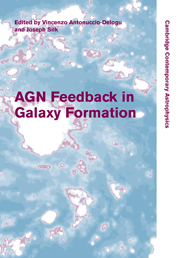Book contents
- Frontmatter
- Contents
- List of contributors
- Preface
- The organising committees
- Part I AGNs, starbursts and galaxy evolution
- 1 The effects of mass and star-formation timescale on galaxy evolution
- 2 Suppressing cluster cooling flows by multiple AGN activity
- 3 Starburst and AGN activity in Spitzer-selected sources at high-z
- 4 Star formation in galaxies hosting active galactic nuclei up to z ∼ 1
- Part II Co-evolution of black holes and galaxies
- Part III Outflows and radio galaxies
- Part IV Models and numerical simulations: methods and results
- Index
2 - Suppressing cluster cooling flows by multiple AGN activity
from Part I - AGNs, starbursts and galaxy evolution
Published online by Cambridge University Press: 10 November 2010
- Frontmatter
- Contents
- List of contributors
- Preface
- The organising committees
- Part I AGNs, starbursts and galaxy evolution
- 1 The effects of mass and star-formation timescale on galaxy evolution
- 2 Suppressing cluster cooling flows by multiple AGN activity
- 3 Starburst and AGN activity in Spitzer-selected sources at high-z
- 4 Star formation in galaxies hosting active galactic nuclei up to z ∼ 1
- Part II Co-evolution of black holes and galaxies
- Part III Outflows and radio galaxies
- Part IV Models and numerical simulations: methods and results
- Index
Summary
Introduction
Models invoking only the central AGN to resolve the cooling flow conundrum in galaxy clusters require fine-tuning of highly uncertain microscopic transport properties to distribute the thermal energy over the entire cluster cooling core. A model in which the ICM is heated instead by multiple, spatially distributed AGNs bypasses most of these difficulties (Nusser et al. 2006). The central regions of galaxy clusters are rich in spheroidal systems, all of which are thought to host black holes and could participate in the heating of the ICM via AGN activity of varying strengths. And they do. There is mounting observational evidence for multiple AGNs in cluster environments. Active AGNs drive bubbles into the ICM. We identify three distinct interactions between the bubble and the ICM: (1) Upon injection, the bubbles expand rapidly in situ to reach pressure equilibrium with their surroundings, generating shocks and waves whose dissipation is the principal source of ICM heating. (2) Once inflated, the bubbles rise buoyantly at a rate determined by balance with the viscous drag force, which itself results in some additional heating. (3) Rising bubbles expand and compress their surroundings. This process is adiabatic and does not contribute to any additional heating; rather, the increased ICM density due to compression enhances cooling. Our model sidesteps the “transport” issue by relying on the spatially distributed galaxies to heat the cluster core. We include self-regulation in our model by linking AGN activity in a galaxy to cooling characteristics of the surrounding ICM.
- Type
- Chapter
- Information
- AGN Feedback in Galaxy Formation , pp. 11 - 20Publisher: Cambridge University PressPrint publication year: 2010

